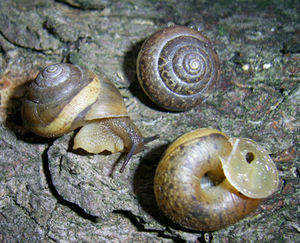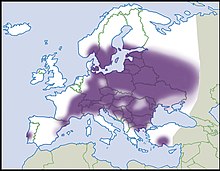Large leaf snail
| Large leaf snail | ||||||||||||
|---|---|---|---|---|---|---|---|---|---|---|---|---|

Great leaf snail ( Euomphalia strigella ) |
||||||||||||
| Systematics | ||||||||||||
|
||||||||||||
| Scientific name | ||||||||||||
| Euomphalia strigella | ||||||||||||
| ( Draparnaud , 1801) |
The large leaf snail ( Euomphalia strigella ) is a species of snail from the family of leaf snails (Hygromiidae) from the order of land snails (Stylommatophora).
features
The fully grown case is 10 to 12 mm high and 12 to 18 mm wide (8 to 12 and 13 to 18 mm). It is spherical with a low-conical, slightly convex top. There are 5 to 6 arched passages, which are separated from each other by a clear seam. The bottom is rounded, the navel is wide open. It is a bit eccentric and takes up about 1/5 of the case diameter. The last turn drops sharply towards the mouth. The mouth is slightly elliptical to egg-shaped. The mouth edge is sharply tapered, turned slightly outwards and reinforced inside by a strong white lip. On the parietal side, the mouth edges come very close.
The shell is quite strong. The housing is yellowish to light brown. The periphery often has a weaker colored, opaque zone. The surface is strongly and irregularly striped. Almost directly at the mouth, a lighter or darker band run parallel to the edge of the mouth. The shells of young specimens are always hairy, the hair is lost in the adult stage.
The soft body is yellowish gray to reddish brown with black spots below the housing. The tentacles are a little darker. The lower tentacles are exceptionally long in relation to the upper tentacles.
In the hermaphroditic genitalia, the free fallopian tube (oviduct) is about as long as the vagina. The spermathec is elongated-egg-shaped with a long stem. Two long, slender appendages with slightly thickened ends arise from the vagina above the atrium. In the further course of the vagina up to the attachment of the spermathec there are three cylindrical branches of the glandulae mucosae , which branch further into two or three branches.
The vas deferens in the male genital tract is not very twisted. It opens into the thick epiphallus, which merges into the penis without any significant constriction. A short flagellum attaches at the point where the spermatic duct enters the epiphallus. The epiphallus is very long, while the penis is very short. The penile retractor muscle inserts on the last third of the epiphallus just before the transition to the penis.
Geographical distribution and habitat
The distribution area extends from northeast Spain, Central and Central Europe, to the Black Sea (Kazan region). Caspian Sea to the Urals. In Scandinavia it has been recorded up to 63 ° N, in Russia up to 61 ° N. Isolated occurrences are known from Portugal and southern Turkey. But it is missing in the British Isles. In Switzerland it is expected to rise up to 2,600 meters, in Bulgaria up to 1,600 meters.
The habitat of the species are warm, rather dry, sun-exposed locations in sparse pine and oak forests, bushes, meadows and dry grasslands with bushes, and in the mountains also rocky slopes. It prefers chalky locations, but not exclusively. In Bulgaria it lives in rather humid, more shady locations in mountain valleys.
Reproduction and way of life
The large leaf snail lives mainly on the ground, where it hides in dry periods under dense scrub, under leaves, in the felt of roots of the vegetation or under moss-covered stones and rubble. They are rarely found in the bush, attached to plants. Only when it rains does it crawl around in its habitat. The animals move very slowly and react to the slightest disturbance by secreting a lot of mucus.
Copulation and oviposition take place between April and mid-May. The animals feed mainly on dead and decaying plant material, also on fresh herbs.
Taxonomy
The taxon was first described as Helix strigella by Jacques Philippe Raymond Draparnaud in 1801 . It is the type species of the genus Euomphalia Westerlund, 1889. The genus and species are generally recognized.
According to MolluscaBase, the species is divided into three subspecies:
- Euomphalia strigella strigella (Draparnaud, 1801), the nominate subspecies
- Euomphalia strigella ruscinica (Bourguignat, 1881), Pyrenees
- Euomphalia strigella mehadiae (Bourguignat, 1881), Bulgaria
Danger
According to Welter-Schultes, the species is endangered locally or its population is declining, primarily due to habitat destruction. Overall, the species is not endangered. Vollrath Wiese names a threat of unknown extent.
literature
- Klaus Bogon: Land snails: biology, ecology, biotope protection. Natur-Verlag, Augsburg 1990, ISBN 3-89440-002-1 , p. 353/53.
- Rosina Fechter, Gerhard Falkner: Mollusks. 287 p., Mosaik-Verlag, Munich 1990 (Steinbach's Nature Guide 10) ISBN 3-570-03414-3 (p. 220)
- Michael P. Kerney, Robert AD Cameron & Jürgen H. Jungbluth: The land snails of Northern and Central Europe. 384 pp., Paul Parey, Hamburg & Berlin 1983, ISBN 3-490-17918-8 (p. 270)
- Francisco W. Welter-Schultes: European non-marine molluscs, a guide for species identification = identification book for European land and freshwater mollusks. A1-A3 S., 679 S., Q1-Q78 S., Göttingen, Planet Poster Ed., 2012 ISBN 3-933922-75-5 , ISBN 978-3-933922-75-5 (hereinafter abbreviated as Welter-Schultes , Identification book with corresponding page number)
- Vollrath Wiese: Germany's land snails. 352 S., Quelle & Meyer, Wiebelsheim 2014, ISBN 978-3-494-01551-4 (in the following abbreviated meadow, land snails with corresponding page number)
Individual evidence
- ↑ a b c Welter-Schultes, Identification Book, p. 502.
- ^ Alexandru V. Grossu: Gastropoda Romaniae 4 Ordo Stylommatophora Suprafam: Arionacea, Zonitacea, Ariophantacea şi Helicacea. 564 S., Bucharest 1983, pp. 456-458.
- ^ A b Roman Egorov: Treaure of Russian Shells. Illustrated catalog of the recent terrestrial molluscs of Russia and adjacent regions. Supplement 5. Moscow, 2008 ISSN 1025-2517, p. 94.
- ^ Jacques Philippe Raymond Draparnaud: Tableau des mollusques terrestres et fluviatiles de la France. Renaud; Bossange, Masson & Besson, Montpellier, Paris 1801, pp. 84/85. Online at Biodiversity Heritage Library
- ↑ MolluscaBase: Euomphalia strigella (Draparnaud, 1801)
- ^ IUCN Red List: Euomphalia strigella
- ↑ Wiese, Landschnecken, p. 292.

